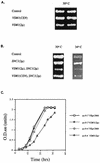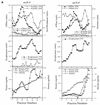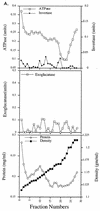Yeast VSM1 encodes a v-SNARE binding protein that may act as a negative regulator of constitutive exocytosis
- PMID: 10330187
- PMCID: PMC104406
- DOI: 10.1128/MCB.19.6.4480
Yeast VSM1 encodes a v-SNARE binding protein that may act as a negative regulator of constitutive exocytosis
Erratum in
- Mol Cell Biol. 2008 Dec;28(24):7534
Abstract
We have screened for proteins that interact with v-SNAREs of the late secretory pathway in the yeast Saccharomyces cerevisiae. A novel protein, designated Vsm1, binds tightly to the Snc2 v-SNARE in the two-hybrid system and can be coimmunoprecipitated with Snc1 or Snc2 from solubilized yeast cell extracts. Disruption of the VSM1 gene results in an increase of proteins secreted into the medium but does not affect the processing or secretion of invertase. In contrast, VSM1 overexpression in cells which bear a temperature-sensitive mutation in the Sec9 t-SNARE (sec9-4 cells) results in the accumulation of non-invertase-containing low-density secretory vesicles, inhibits cell growth and the secretion of proteins into the medium, and blocks rescue of the temperature-sensitive phenotype by SNC1 overexpression. Yet, VSM1 overexpression does not affect yeast bearing a sec9-7 allele which, in contrast to sec9-4, encodes a t-SNARE protein capable of forming a stable SNARE complex in vitro at restrictive temperatures. On the basis of these results, we propose that Vsm1 is a novel v-SNARE-interacting protein that appears to act as negative regulator of constitutive exocytosis. Moreover, this regulation appears specific to one of two parallel exocytic paths which are operant in yeast cells.
Figures










Similar articles
-
Phosphorylation of the autoinhibitory domain of the Sso t-SNAREs promotes binding of the Vsm1 SNARE regulator in yeast.Mol Biol Cell. 2003 Aug;14(8):3114-25. doi: 10.1091/mbc.e02-12-0804. Epub 2003 May 3. Mol Biol Cell. 2003. PMID: 12925750 Free PMC article.
-
Involvement of long chain fatty acid elongation in the trafficking of secretory vesicles in yeast.J Cell Biol. 1998 Nov 30;143(5):1167-82. doi: 10.1083/jcb.143.5.1167. J Cell Biol. 1998. PMID: 9832547 Free PMC article.
-
Yeast homologues of tomosyn and lethal giant larvae function in exocytosis and are associated with the plasma membrane SNARE, Sec9.J Cell Biol. 1999 Jul 12;146(1):125-40. doi: 10.1083/jcb.146.1.125. J Cell Biol. 1999. PMID: 10402465 Free PMC article.
-
Analysis of a yeast SNARE complex reveals remarkable similarity to the neuronal SNARE complex and a novel function for the C terminus of the SNAP-25 homolog, Sec9.J Biol Chem. 1997 Jun 27;272(26):16610-7. doi: 10.1074/jbc.272.26.16610. J Biol Chem. 1997. PMID: 9195974
-
SNARE Protein Snc1 Is Essential for Vesicle Trafficking, Membrane Fusion and Protein Secretion in Fungi.Cells. 2023 Jun 5;12(11):1547. doi: 10.3390/cells12111547. Cells. 2023. PMID: 37296667 Free PMC article. Review.
Cited by
-
t-SNARE dephosphorylation promotes SNARE assembly and exocytosis in yeast.EMBO J. 2001 Feb 1;20(3):411-21. doi: 10.1093/emboj/20.3.411. EMBO J. 2001. PMID: 11157748 Free PMC article.
-
Loss of the extraproteasomal ubiquitin receptor Rings lost impairs ring canal growth in Drosophila oogenesis.J Cell Biol. 2011 Apr 4;193(1):71-80. doi: 10.1083/jcb.201009142. Epub 2011 Mar 28. J Cell Biol. 2011. PMID: 21444692 Free PMC article.
-
Phosphorylation of the autoinhibitory domain of the Sso t-SNAREs promotes binding of the Vsm1 SNARE regulator in yeast.Mol Biol Cell. 2003 Aug;14(8):3114-25. doi: 10.1091/mbc.e02-12-0804. Epub 2003 May 3. Mol Biol Cell. 2003. PMID: 12925750 Free PMC article.
-
HIV proteinase inhibitors target the Ddi1-like protein of Leishmania parasites.FASEB J. 2011 May;25(5):1729-36. doi: 10.1096/fj.10-178947. Epub 2011 Jan 25. FASEB J. 2011. PMID: 21266539 Free PMC article.
-
Ddi1 is a ubiquitin-dependent protease.Proc Natl Acad Sci U S A. 2020 Apr 7;117(14):7776-7781. doi: 10.1073/pnas.1902298117. Epub 2020 Mar 19. Proc Natl Acad Sci U S A. 2020. PMID: 32193351 Free PMC article.
References
-
- Aalto M K, Ruohonen L, Hosono K, Keranen S. Cloning and sequencing of the yeast Saccharomyces cerevisiae SEC1 gene localized on chromosome IV. Yeast. 1992;8:587–588. - PubMed
-
- Ames B N. Assay of inorganic phosphate, total phosphate, and phosphatases. Methods Enzymol. 1966;8:115–118.
-
- Araki S, Tamori Y, Kawanishi M, Shinoda H, Masugi J, Mori H, Niki T, Okazawa H, Kubota T, Kasuga M. Inhibition of the binding of SNAP-23 to syntaxin 4 by Munc18c. Biochem Biophys Res Commun. 1997;234:257–262. - PubMed
Publication types
MeSH terms
Substances
Associated data
- Actions
LinkOut - more resources
Full Text Sources
Other Literature Sources
Molecular Biology Databases
